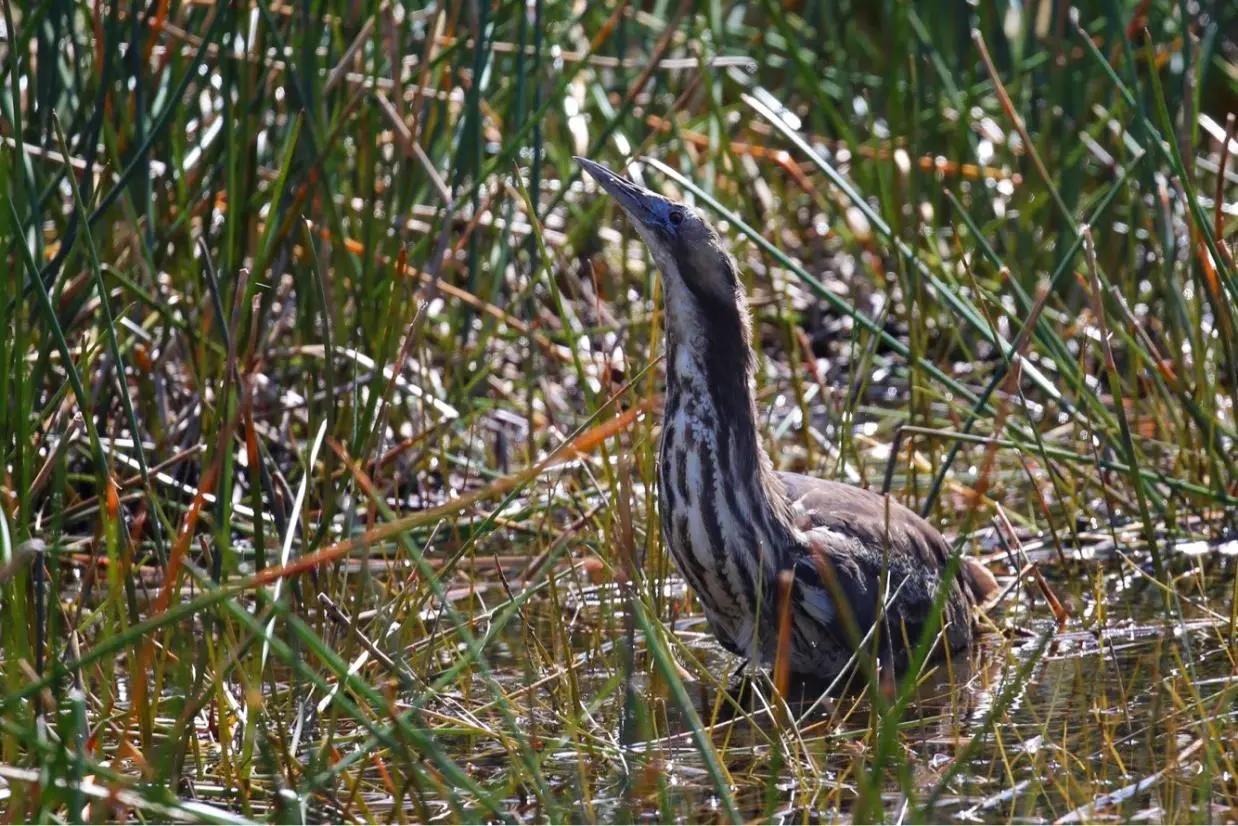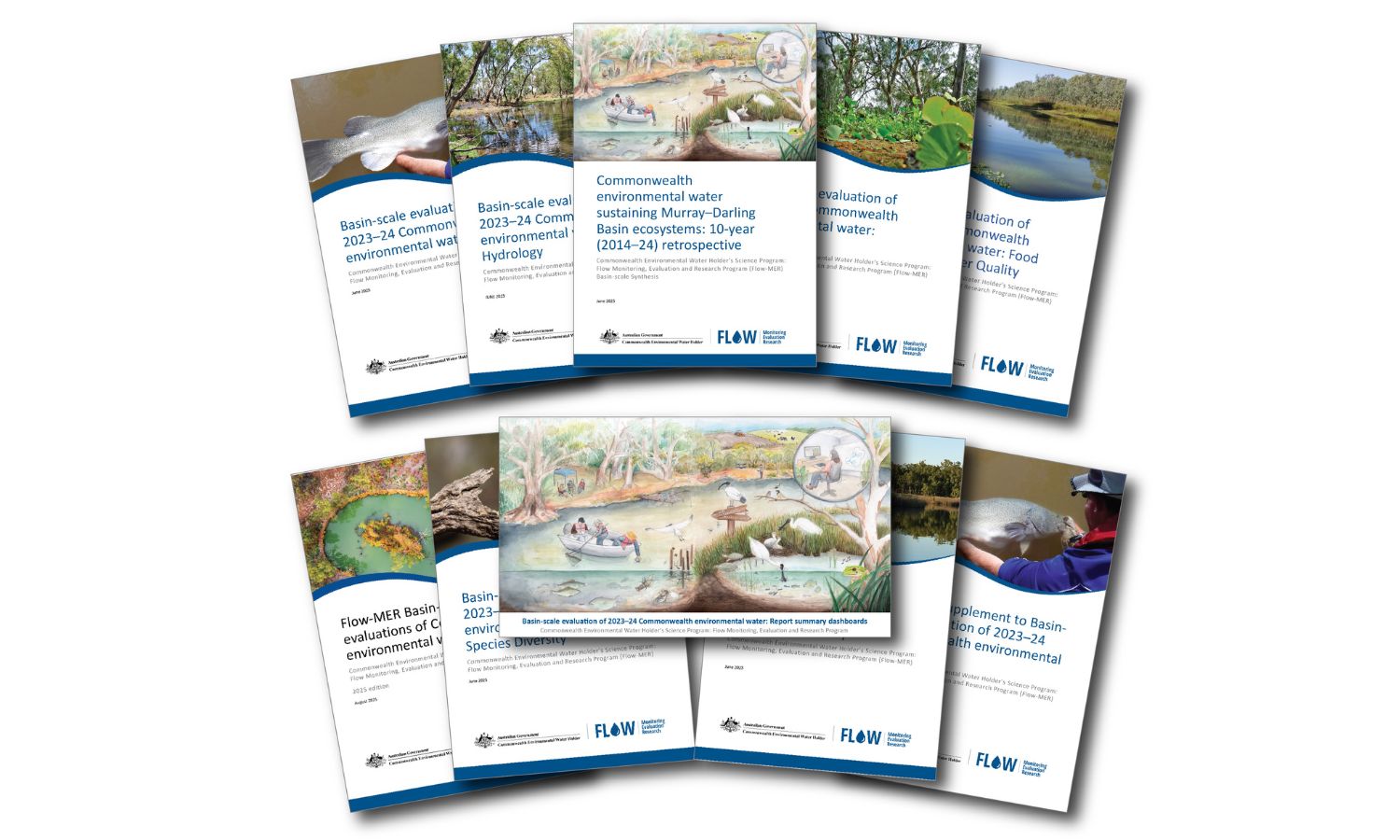Since 2014, the NSW Department of Climate Change, Energy, the Environment and Water (NSW DCCEEW) and the University of New England (UNE) have been monitoring waterbirds in the Gingham, Lower Gwydir, and Mallowa Wetlands. This work has been undertaken as part of the Commonwealth Environmental Water Holder’s (CEWH) Flow-MER Program and previous CEWH science programs.
The aim of this project is to track waterbird response to both CEWH and NSW environmental water deliveries. In the 2024-25 water year, waterbirds were monitored four times, including before, during and after watering events. The first survey was conducted in November 2024, before the environmental water arrived in the wetlands, the second in January 2025 when the wetlands were filling, and the third in February 2025 to capture response to peak water levels. The final survey was conducted in May 2025 to observe post-watering responses.
Evening survey reveals rare bittern calls
On an evening survey in the Gwydir Wetlands in January 2025, the sunset chorus of birdsong showed that the dense vegetation of a flooded rushland hid some seldom-seen species. The calls of at least three Australian little bitterns (Botaurus dubius) could be heard – not unexpected in this habitat, but always a welcome sign that the system is in good condition. These very small bitterns have declined in numbers but are still widespread in suitable habitat. More surprisingly, the call of an Australasian bittern (Botaurus poiciloptilus) was then heard – a distinctive series of deep ‘booming’ notes. The calls can be heard for several kilometres and are often thought to be the source of ‘bunyip’ legends. The much larger Australasian bittern is listed as endangered throughout its shrinking Australian range. It is otherwise only found in smaller numbers in New Zealand and New Caledonia, though it may be extinct in the latter.
Recent estimates of the Australian population are as low as 1,300 individuals, though there is considerable uncertainty about the accuracy of this figure.
Listening for bitterns: Survey methods
Bitterns have traditionally been surveyed by listening for their calls, especially around dawn and dusk. At these times the males call most persistently, though in the peak of the breeding season they may ‘boom’ throughout the day and night. Observers stationed at different points around a wetland can triangulate in an effort to pinpoint the approximate position of each male. This can be difficult as the very low-frequency call carries a long distance. In ideal conditions, calls can be heard at least five kilometres away and possibly up to eight kilometres. With repeated surveys, the number of different males calling in a wetland can be roughly estimated from the calling positions. However, the advent of acoustic monitoring has made identification of individual males easier and numbers more reliable. Each male has its own ‘signature’ sound, with its booms repeated a certain number of times and at a fixed frequency. The main uncertainty about population estimates now is the unknown sex ratio – how many female birds are there for each male? This number makes a big difference to population estimates and viability, but for now our only option is to use calling males as a proxy for the population and a focus for management.
Signs of breeding and a rare sighting
The Australasian bittern was formerly considered a regularly breeding species in the Gwydir catchment, but with the gradual decline in extent of wetlands it is now very rarely recorded. The bird heard in January 2025 was a male and was presumably attempting to breed. This is because only the males call, and the booming advertisement calls are generally used to find a mate. Whether or not it found a mate or nested remains unknown. The re-establishment of a breeding population in the Gwydir will only be confirmed if more males are heard each summer and successful nesting is discovered. The latter, like most things to do with bitterns, is difficult due to their cryptic nature. Therefore, perhaps even more surprising was a sighting of an Australasian Bittern on the edge of wetlands in the Mallowa Creek in early May 2025 by landholder Jon Guyer at Valetta. The identification was confirmed by video of the bird, flushed out of hiding in dense vegetation.
Video caption: An Australasian bittern on the edge of wetlands in the Mallowa Creek (courtesy of Jon Guyer).
Habitat requirements for breeding success
In most of their range, Australasian bitterns rely mainly on tall emergent aquatic vegetation as habitat. Dense reedbeds, cumbungi, and tall rushes are most often used for nesting sites – as long as the surrounding water depth is at least 30cm and remains steady throughout the nesting period of three months.
Inundation over a pre-breeding period of about two months is required to allow the establishment of food resources. Therefore, a total inundation of at least 149 days is needed for successful breeding.
Open water around the edges of the vegetation is necessary for foraging, as bitterns rely on good visibility for hunting their preferred prey of fishes, frogs, crustaceans, and insects. A mosaic of dense vegetation and open water may best be maintained by periodic drying of the wetlands, which prevents reeds or cumbungi from colonising all the open areas. Outside the breeding season, bitterns are known to use a wider variety of habitats including flooded lignum and other shrublands, as well as irrigation channels and dams – and they occasionally even stray into parks, or gardens with fishponds.
Hope for a breeding comeback in the Gwydir
These records of bitterns from the Gwydir come at a time when the potential for local breeding is good – floodplain wetlands are inundated and, with continued inflows, some areas may well remain so for months. This will ‘prime’ the wetlands in the lead-up to the breeding season of spring-summer. The Gwydir birds may be wanderers from established bittern breeding areas to the south, where a recent series of wet years and environmental watering has likely resulted in good breeding success. This can be followed by young birds leaving their natal areas to search for new opportunities. Australasian bitterns are capable dispersers, as revealed by tracking studies, covering large distances to find suitable habitat. More surveys in the coming spring will tell us if water and wandering have aligned to bring more ‘bunyips’ back to the Gwydir.




